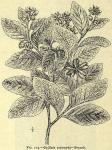
 The dried bark derived of the periderm of Quilla'ja sapona'ria Molina.
The dried bark derived of the periderm of Quilla'ja sapona'ria Molina.
DESCRIPTION OF DRUG.—In rather thick, flattish pieces of various sizes, deprived of the corky layer; outer surface brownish-white, sometimes with patches of the reddish-brown cork adhering; when held up to the light it shows numerous glistening crystals of calcium oxalate, which are scattered throughout the tissue. Fracture tough and is fibrous, a transverse section showing a checkered arrangement of pale brown bast fibers imbedded in the white wood. Odorless; taste persistently acrid. The powder is sternutatory. The powder of quillaja has been suspected as an adulterant of senega. It is not at all difficult to detect its presence in such admixtures, as in quillaja powder there are found elements not at all represented in senega. In quillaja there is a considerable amount of sclerotic tissue, numerous bast fibers, and prismatic crystals of calcium oxalate. Any and all of these clearly mark the powder of quillaja, and would at once betray its presence in the powder of senega.
Powder.—Grayish. Inner parenchyma of cortex colorless (15 to 25 µ by 50 to 150 µ in diam.), mostly with large, long prisms of calcium oxalate; parenchyma of cortex with starch (3 to 10 µ in diam.); sclerenchyma with bast fibers (20 to 30 µ in diam.), thick-walled, porous, occasionally branched; stone cells (50 to 150 µ in diam.).
CONSTITUENTS.—Its irritant property is due to the presence of saponin, C19H30O10, a mixture of the two glucosides, quillaiac acid and sapotoxin.
Preparation of Saponin.—Exhaust quillaja with hot alcohol, from which it separates upon cooling. Saponin is regarded as a mixture of two glucosides, quillaiac acid and sapotoxin.
ACTION AND USES.—Containing about the same principles as senega, it has been recommended as a substitute for that drug as an expectorant in pulmonary affections. Dose: 15 to 30 gr. (1 to 2 Gm.).

